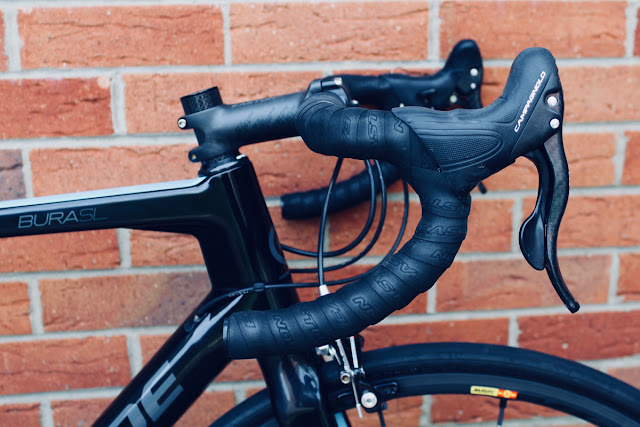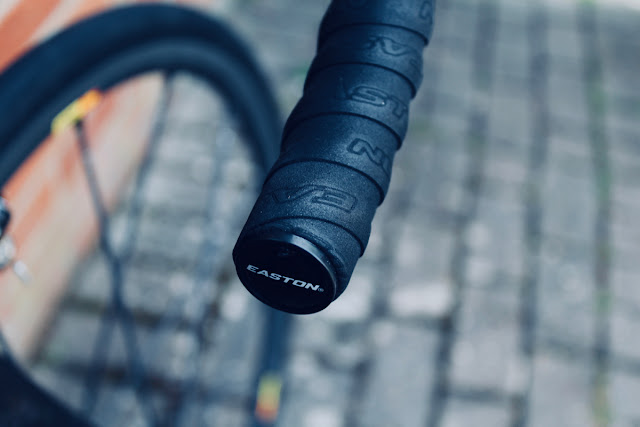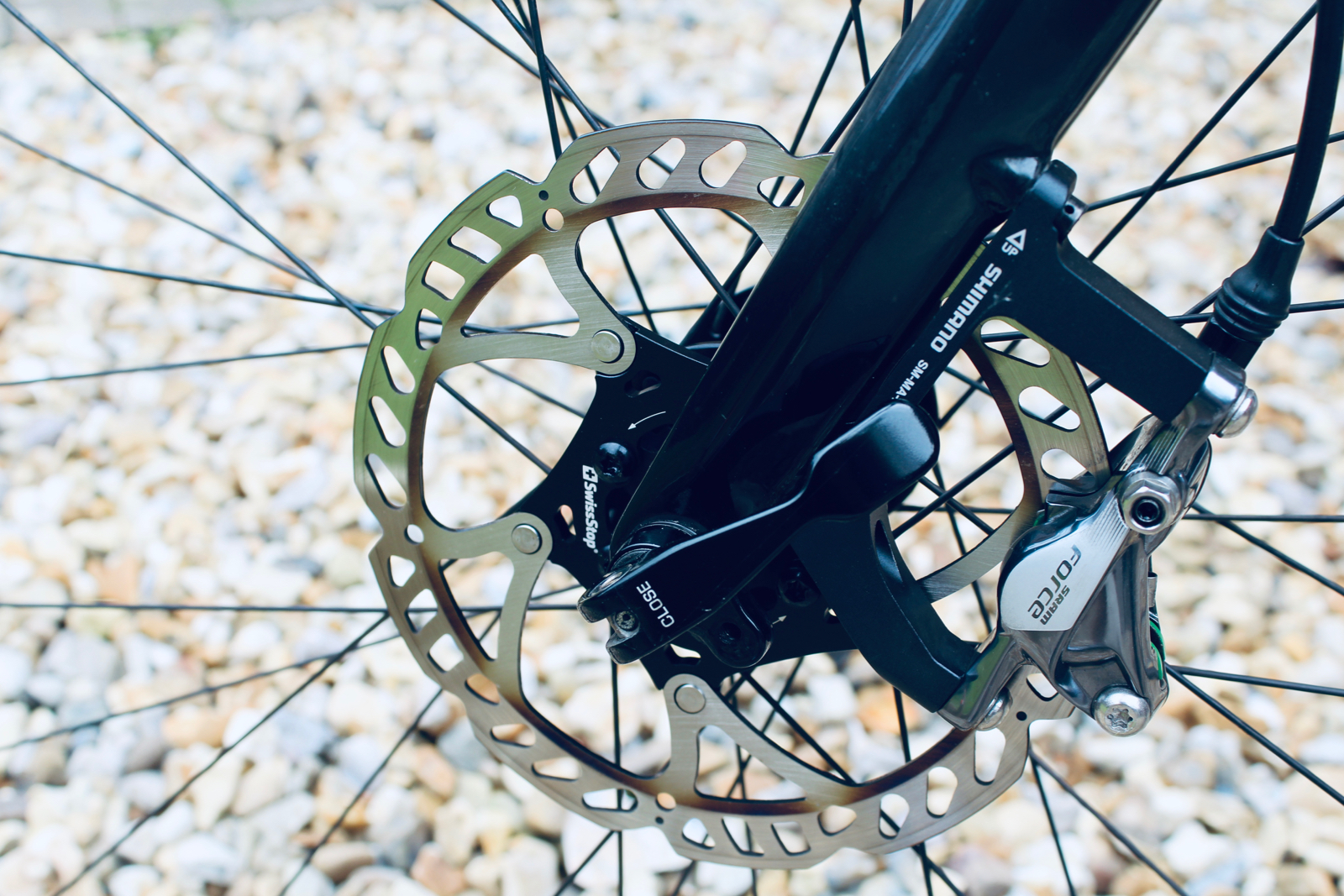Tech Talk - Cockpits - Narrow Handlebars and Shorter Stems
I am constantly micro-adjusting the set-up on my bikes to find the most comfortable and powerful position. The latest upgrade to my road bike is a set of narrower Easton carbon handlebars and a shorter stem. It is a marked improvement. Here's why…
The standard large size road bike (56cm) will come with a 100mm stem and 42cm handlebars. Most 'racers' will whip that 'short' stem straight off, and replace it with anything up to 130mm in length. Most will stick with the 42cm width handlebars though. Both of these choices seems increasingly illogical, in my opinion…
The trend for long stems in the pro peloton relates to the tradition of opting for a smaller frame size, something that was done in bygone years because it helped to reduce weight. Something that is largely unnecessary now, because all top-end bikes are under the UCI weight limit; yet the tradition continues, because cyclists love tradition.
You would often see a rider on a 54cm bike, when in truth they should be riding a 56cm; they put a longer stem and seat post on to compensate for the shorter top tube and seat tube. The reality is that if your bike is the correct size for you, you shouldn't need a stem longer than 110mm.
I admit that I used to use a long 120mm stem on my road bike, despite riding a 56cm - the correct frame size for me. I have recently dropped back to a 110mm, and now even to a 100mm Easton EC70 SL Stem for ultra-endurance riding.
The shorter stem length makes a lot of sense. Experiencing lower back pain? You could well be too stretched out. Handling feel sluggish? That long stem slows down the reaction time of your bike's steering. Struggling with putting the power down? A stretched out position reduces the amount you can use your powerful lower back muscles for pedalling.
Quite simply, a shorter stem helps to improve handling, and often improve comfort and performance too. It is a trend that has been seen in mountain biking for some time, and also on track bikes.
My EC70 SL Easton Carbon Stem has undoubtedly improved comfort and performance out on the road.
For comfort, handlebar width should be aligned with shoulder width; a rough measurement guide being that your handlebars should be the same width as the distance between the acromioclavicular joints (the boney lumps that stick up on your shoulders). If you are someone like me, then you might have a 33-inch inseam (requiring a large size bike frame), but this shoulder distance is less than 42cm. In all likelihood you could benefit from downsizing your handlebar width, to improve comfort with a better fit.
Narrower handlebars are also more aerodynamic. They help to reduce the frontal area of your torso, so reduce wind resistance (think of the TT position). This is the main reason that most professionals are downsizing their bars.
Carbon fibre is noted for its vibration absorbing qualities, and the change to the Easton EC70 SL bars has had a notable effect on reducing and almost eliminating the problem. If you suffer from fatigue in your hands then carbon bars could well be worth the investment.
To sum up, there are both performance and comfort benefits of changing the cockpit set-up on your road bike. It is one of the least altered aspects of a bike, but one that represents a significant contact point and is therefore worth addressing.
>> View the Easton range of carbon handlebars here <<
The standard large size road bike (56cm) will come with a 100mm stem and 42cm handlebars. Most 'racers' will whip that 'short' stem straight off, and replace it with anything up to 130mm in length. Most will stick with the 42cm width handlebars though. Both of these choices seems increasingly illogical, in my opinion…
Stem Length
The main motivation for opting to upsize a stem seems to be "it's what the Pro's do".The trend for long stems in the pro peloton relates to the tradition of opting for a smaller frame size, something that was done in bygone years because it helped to reduce weight. Something that is largely unnecessary now, because all top-end bikes are under the UCI weight limit; yet the tradition continues, because cyclists love tradition.
You would often see a rider on a 54cm bike, when in truth they should be riding a 56cm; they put a longer stem and seat post on to compensate for the shorter top tube and seat tube. The reality is that if your bike is the correct size for you, you shouldn't need a stem longer than 110mm.
I admit that I used to use a long 120mm stem on my road bike, despite riding a 56cm - the correct frame size for me. I have recently dropped back to a 110mm, and now even to a 100mm Easton EC70 SL Stem for ultra-endurance riding.
The shorter stem length makes a lot of sense. Experiencing lower back pain? You could well be too stretched out. Handling feel sluggish? That long stem slows down the reaction time of your bike's steering. Struggling with putting the power down? A stretched out position reduces the amount you can use your powerful lower back muscles for pedalling.
Quite simply, a shorter stem helps to improve handling, and often improve comfort and performance too. It is a trend that has been seen in mountain biking for some time, and also on track bikes.
My EC70 SL Easton Carbon Stem has undoubtedly improved comfort and performance out on the road.
Handlebars
Whilst stem length is something typically larger in the pro peloton than it is in the amateur ranks; handlebar width is tending the other way, with narrower bars becoming increasingly more popular.For comfort, handlebar width should be aligned with shoulder width; a rough measurement guide being that your handlebars should be the same width as the distance between the acromioclavicular joints (the boney lumps that stick up on your shoulders). If you are someone like me, then you might have a 33-inch inseam (requiring a large size bike frame), but this shoulder distance is less than 42cm. In all likelihood you could benefit from downsizing your handlebar width, to improve comfort with a better fit.
Narrower handlebars are also more aerodynamic. They help to reduce the frontal area of your torso, so reduce wind resistance (think of the TT position). This is the main reason that most professionals are downsizing their bars.
Carbon Upgrade
It is also worth a short note of praise for the switch from alloy to carbon handlebars. Over long distance rides like the #BlackForest400 I have previously experience numbness in my hands, which I decided came from the 'road buzz' over the course of 20+ hours of riding.Carbon fibre is noted for its vibration absorbing qualities, and the change to the Easton EC70 SL bars has had a notable effect on reducing and almost eliminating the problem. If you suffer from fatigue in your hands then carbon bars could well be worth the investment.
To sum up, there are both performance and comfort benefits of changing the cockpit set-up on your road bike. It is one of the least altered aspects of a bike, but one that represents a significant contact point and is therefore worth addressing.
>> View the Easton range of carbon handlebars here <<








The comment about most pro bikes are under UCI weight limits is largely untrue, it is a common thought, but I have seen several pro bikes weighed over past 5 years. Many were closer to 16 to 16 1/2# than 15# with pedals-water bottle cages- computers'- power meters-disk brakes. All of which are part of UCI weight guidance numbers. Those who run clinchers often closer to 16 1/2##. Pros except going up mountains do not seem to be as worried about bike weight as most of us.Even when rider weight is under 150#.
ReplyDelete